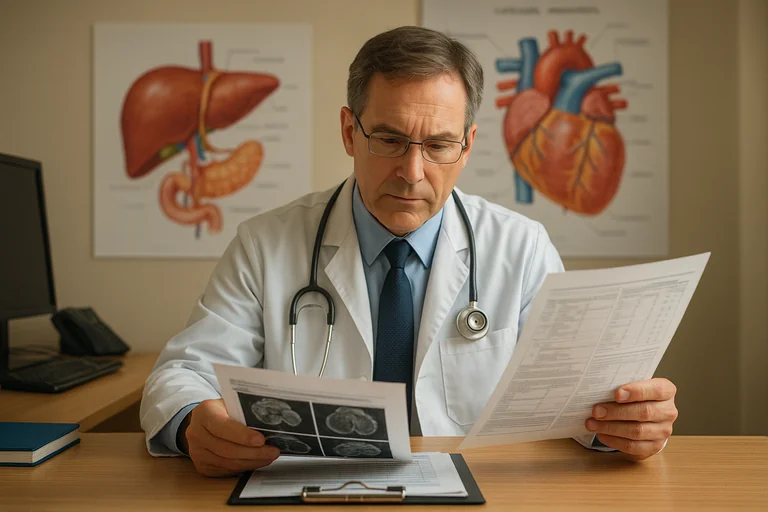A 2 minute assessment to get a personalized mental health or alcohol recovery plan.
When you're prescribed antibiotics, understanding how alcohol affects their effectiveness isn't just medical advice—it's potentially life-saving information that affects millions of Americans each year.
The relationship between alcohol and antibiotics is more complex than most people realize. While moderate alcohol consumption doesn't reduce the effectiveness of most antibiotics, certain combinations can trigger severe reactions including flushing, vomiting, and rapid heart rate. Even more concerning, alcohol can amplify side effects and interfere with your body's healing process.
Here's what makes this particularly critical: if you're dealing with both an infection requiring antibiotics and alcohol use concerns, you're facing a dual challenge that demands careful navigation. According to the National Institute on Alcohol Abuse and Alcoholism, an estimated 29.5 million people ages 12 and older had alcohol use disorder in 2021, which can complicate antibiotic treatment and recovery.
Understanding these interactions becomes even more crucial when considering comprehensive treatment approaches like the Addiction Iceberg Program, which addresses both the visible symptoms and hidden roots of addiction while managing co-occurring health conditions.
The Hidden Complexity of Alcohol-Antibiotic Interactions
Why This Matters More Than You Think
Before diving into specific interactions, let's address the fundamental issue: your body processes both alcohol and antibiotics through the liver. The liver metabolizes approximately 90% of consumed alcohol, and many antibiotics follow similar pathways.
This shared processing creates potential for: - Competitive inhibition: Alcohol and antibiotics competing for the same enzymes - Increased toxicity: Overwhelmed liver function leading to medication buildup - Reduced effectiveness: Altered drug metabolism changing antibiotic levels
Most concerning is that chronic alcohol use changes liver enzyme production, potentially altering how your body handles medications long after your last drink.
The Antibiotics You Absolutely Cannot Mix with Alcohol
While many antibiotics are relatively safe with moderate alcohol consumption, several create dangerous reactions:
Metronidazole (Flagyl): This antibiotic causes a disulfiram-like reaction when combined with alcohol, resulting in symptoms including flushing, headaches, nausea, vomiting, and chest pain. The reaction can occur up to 3 days after stopping the medication.
Tinidazole (Tindamax): Similar to metronidazole, this medication blocks acetaldehyde dehydrogenase, causing toxic acetaldehyde buildup when alcohol is consumed.
Cefotetan and Cefoperazone: These cephalosporin antibiotics can trigger disulfiram-like reactions, though less predictably than metronidazole.
Understanding the Iceberg: When Infection Meets Addiction
The Visible vs. Hidden Impact
Like an iceberg, the interaction between alcohol and antibiotics has visible symptoms above the surface and deeper complications below. The Addiction Iceberg Program recognizes this dual nature, addressing both immediate medical needs and underlying addiction issues.
Research shows that people with alcohol use disorder have higher rates of infections and poorer treatment outcomes. When someone struggles with alcohol use while needing antibiotic treatment, addressing only the infection ignores the larger problem.
Above the surface (visible symptoms): - Antibiotic side effects - Acute alcohol-drug interactions - Treatment non-compliance
Below the surface (root causes): - Alcohol use disorder - Depression or anxiety driving alcohol use - Neurobiological changes from chronic drinking
Why Traditional Approaches Fall Short
Standard medical care often treats the infection with antibiotics while merely advising patients to avoid alcohol. This approach fails because:
- Withdrawal risks: Alcohol withdrawal can begin as early as 6 hours after the last drink, with symptoms ranging from mild anxiety to life-threatening seizures
- Compliance issues: Without addressing addiction, patients often continue drinking
- Missed opportunities: The medical encounter could catalyze comprehensive treatment
The Science Behind Combined Treatment: Ketamine and Naltrexone
Revolutionary Findings from Recent Research
Groundbreaking research is revealing how innovative medication combinations can address both addiction and co-occurring conditions. A 2019 Yale University study published in JAMA Psychiatry examined five patients with both alcohol use disorder and major depression who received combined ketamine and naltrexone treatment.
The results showed: - Significant improvement in depressive symptoms - Good tolerability of the combination - No serious adverse effects were observed - Potential for addressing both conditions simultaneously
This contradicts earlier concerns that naltrexone might interfere with ketamine's antidepressant effects, opening new possibilities for integrated treatment.
How Each Medication Works
Ketamine: Acts as an NMDA receptor antagonist, providing rapid relief from depression symptoms. Studies show ketamine can improve drinking outcomes when combined with therapy.
Naltrexone: Blocks opioid receptors, reducing alcohol's rewarding effects and helping decrease alcohol consumption.
The synergy occurs because ketamine addresses the immediate mental health crisis while naltrexone provides long-term addiction management—crucial when someone needs antibiotics but struggles with alcohol use.
Managing Antibiotics During Addiction Treatment
The Integrated Approach
The Addiction Iceberg Program's comprehensive model becomes particularly valuable when medical issues like infections arise. Here's how integrated treatment addresses antibiotic needs:
Medical Stabilization: - Careful antibiotic selection avoiding high-risk interactions - Monitoring liver function - Managing withdrawal if needed
Mental Health Support: - Ketamine therapy for rapid symptom relief - Addressing anxiety about medical treatment - Building coping strategies
Addiction Management: - Naltrexone to reduce cravings - Preventing relapse during medical stress - Long-term recovery planning
Timing and Coordination
Research indicates that alcohol withdrawal symptoms typically peak at 24-72 hours after the last drink, requiring specific timing considerations for optimal outcomes:
- Alcohol cessation: Ideally 24+ hours before ketamine administration
- Naltrexone initiation: After acute withdrawal subsides
- Antibiotic treatment: Coordinated with addiction medications
This coordinated approach ensures antibiotics work effectively while supporting recovery.
Real-World Application: What This Means for You
If You're Currently Taking Antibiotics
The question "does alcohol affect antibiotics" has nuanced answers depending on your situation:
For occasional drinkers: - Check specific antibiotic interactions - Consider abstaining during treatment - Monitor for adverse effects
For regular/heavy drinkers: - Disclose alcohol use to prescribers - Don't stop drinking suddenly without medical supervision due to potential withdrawal complications - Consider this an opportunity for comprehensive evaluation
Recognizing When You Need Integrated Treatment
The NIAAA reports that alcohol use disorder affects approximately 10.6% of people ages 12 and older in the United States, yet most never receive treatment. If you're asking about alcohol and antibiotics, consider whether you're experiencing:
- Difficulty abstaining even for medical reasons
- Anxiety about not drinking during antibiotic treatment
- Past negative reactions when mixing alcohol and medications
- Repeated infections or slow healing (possibly alcohol-related)
The Comprehensive Solution: Addressing Root Causes
Beyond Surface-Level Treatment
The Addiction Iceberg Program represents a paradigm shift in treating co-occurring conditions. Rather than simply managing symptoms, it addresses underlying causes through:
Rapid Stabilization: - Ketamine therapy provides relief within hours to days - Reduces immediate distress that might lead to drinking - Creates mental clarity for engaging in treatment
Sustained Recovery: - Naltrexone maintains progress over weeks to months - Reduces cravings during stressful periods (like illness) - Supports long-term behavior change
Integrated Care: - Coordinates medical needs (like antibiotics) with addiction treatment - Addresses mental health driving substance use - Provides comprehensive support system
The Evidence for Integrated Treatment
The Yale study found the ketamine-naltrexone combination to be a potentially viable treatment option for patients with comorbid alcohol use disorder and depression. This integrated approach shows promise for patients facing multiple challenges simultaneously.
Additional research demonstrates: - Ketamine has shown rapid antidepressant effects in treatment-resistant depression - Naltrexone is FDA-approved for alcohol use disorder and helps reduce heavy drinking days - Combined treatment addresses both acute and chronic aspects of addiction
Moving Forward: Your Path to Integrated Health
The Critical Decision Point
If you're searching for information about alcohol and antibiotics, you're at a crucial juncture. This moment of medical need could become the catalyst for comprehensive change. The Addiction Iceberg Program offers:
- Immediate Support: Rapid symptom relief through ketamine therapy
- Medical Coordination: Safe antibiotic treatment within addiction care
- Long-term Solutions: Naltrexone and therapy for sustained recovery
- Comprehensive Healing: Addressing visible symptoms and hidden causes
Why Timing Matters
Research shows that individuals are often more motivated to change during health crises. When you need antibiotics but struggle with alcohol, you're facing immediate consequences of continued use. This creates a unique opportunity for transformation.
The Addiction Iceberg Program leverages this moment by: - Providing immediate relief from distressing symptoms - Supporting safe medical treatment - Building foundation for lasting recovery - Addressing root causes, not just surface issues
The Science of Hope: Why This Approach Works
Neurobiological Healing
The ketamine-naltrexone combination works at the brain level to create lasting change. Ketamine has been shown to promote synaptogenesis and enhance synaptic plasticity, potentially helping to repair neural pathways affected by chronic alcohol use.
Meanwhile, naltrexone blocks the reinforcing effects of alcohol by antagonizing opioid receptors, allowing new, healthier patterns to establish. This dual approach addresses both the immediate crisis and long-term recovery needs.
Beyond Medication: Comprehensive Care
While medications provide crucial support, the Addiction Iceberg Program integrates: - Psychotherapy to process underlying trauma - Medical monitoring for safe treatment - Lifestyle interventions for sustained health - Community support for ongoing recovery
This comprehensive approach ensures that when you need antibiotics in the future, alcohol interactions won't be a concern because you'll have achieved lasting recovery.
Ready to Address the Root Causes of Your Alcohol Use?
If you're concerned about how alcohol affects your antibiotic treatment, it might be time to explore comprehensive solutions that address both your immediate medical needs and underlying addiction. The Addiction Iceberg Program offers integrated treatment that goes beyond surface symptoms to create lasting change.
References
- Yoon G, Petrakis IL, Krystal JH. "Association of Combined Naltrexone and Ketamine With Depressive Symptoms in a Case Series of Patients With Depression and Alcohol Use Disorder." JAMA Psychiatry. 2019;76(3):337-338.
- National Institute on Alcohol Abuse and Alcoholism. "Understanding Alcohol Use Disorder." NIAAA Publications. 2023.
- Substance Abuse and Mental Health Services Administration. "Alcohol Withdrawal." SAMHSA Clinical Guidelines. 2023.
- National Center for Biotechnology Information. "Delirium Tremens." StatPearls. 2023.
- American Academy of Family Physicians. "Alcohol Withdrawal Syndrome." American Family Physician. 2004;69(6):1443-1450.
- Cederbaum AI. "Alcohol metabolism." Clinics in Liver Disease. 2012;16(4):667-685.
- Weathermon R, Crabb DW. "Alcohol and medication interactions." Alcohol Research & Health. 1999;23(1):40-54.
- Szabo G, Saha B. "Alcohol's Effect on Host Defense." Alcohol Research. 2015;37(2):159-170.
- Krystal JH, et al. "Rapid-acting glutamatergic antidepressants: the path to ketamine and beyond." Biological Psychiatry. 2013;73(12):1133-1141.
- Anton RF. "Naltrexone for the management of alcohol dependence." New England Journal of Medicine. 2008;359:715-721.
- Zarate CA Jr, et al. "Replication of ketamine's antidepressant efficacy in bipolar depression." Biological Psychiatry. 2012;71(11):939-946.
- Kelly TM, Daley DC. "Integrated treatment of substance use and psychiatric disorders." Social Work in Public Health. 2013;28(3-4):388-406.
- Zanos P, Gould TD. "Mechanisms of ketamine action as an antidepressant." Molecular Psychiatry. 2018;23(4):801-811.
- Gueorguieva R, et al. "Naltrexone and combined behavioral intervention effects on trajectories of drinking." Alcoholism: Clinical and Experimental Research. 2010;34(9):1558-1567.




